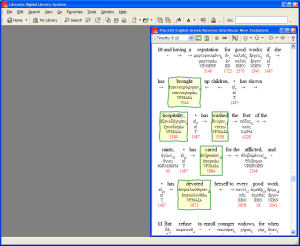It’s cool to see features and datasets combine in ways that weren’t originally anticipated.
Just the other day, Eli and I were talking with Dale Pritchett (VP Marketing and Bob’s father!) and Dale wondered about how to highlight an English text based on Greek or Hebrew morphology. Sort of like this:
Eli and I looked at each other quizzically. Then at about the same time we had the answer: Reverse Interlinear! And the cool part is that the feature already works in Logos Bible Software 3! It is a consequence of having data and functionality already in place, we just hadn’t quite stopped to realize the extent of the functionality. But it is a consequence of:
- Having Reverse Interlinears available that align the original language texts (Greek and Hebrew) with a modern language translation at the word level.
- Having morphological information in the original language texts underlying the English translation of the Reverse Interlinear.
- Having a Visual Filter (a method of overlaying highlighting based on specified criteria) for morphologies.
Because of the architecture of Logos Bible Software … well, it just works. Nothing extra needed.
Here’s a short video (Flash, approx. 0.7 MB, no sound) that walks through how to specify the visual filter for the reverse interlinear. It walks through setting up a visual filter that highlights where finite verbs (i.e., verbs in the indicative, imperative, subjunctive or optative moods) occur in the Aorist tense. These will be visually highlighted with the “Box” style, so you can simply see them as you scroll through the text. And you’ll see how the ESV handles translating them. After the visual filter is set, I then show how interlinear lines are customizable. In the end, you see only the English text of the ESV, but the English words that represent the aorist verbs are highlighted … and no Greek is in sight.
Video: Flash, approx. 0.7 MB, no sound
Pretty cool. Give it a try if you’re running the Release Candidate!






